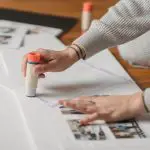Are you looking to add some elegant flair to your fabric project? Learn how to glue satin ribbon to fabric and achieve professional-looking results.
In this guide, you’ll discover the steps to choose the right glue, prepare your fabric and ribbon, apply the glue, position the ribbon, and secure it in place.
Plus, we’ll provide tips for drying and curing time, adding embellishments, and caring for your finished masterpiece.
Let’s get started!
Table of Contents
Choosing the Right Glue
To choose the right glue for gluing satin ribbon to fabric, you’ll want to consider the type of fabric you’re working with and the durability you desire.
There are various adhesive types you can choose from, each with its own benefits and considerations.
One popular option is fabric glue, which is specifically designed for bonding fabric materials. It provides a strong and flexible bond, making it ideal for satin ribbons on fabric.
Another option is hot glue, which is quick and easy to use. However, it may not be suitable for delicate fabrics as it can be quite strong and may leave visible marks.
Additionally, you can also use double-sided tape, which is a convenient and temporary method for attaching satin ribbons to fabric.
When it comes to adhesive application, it’s important to apply the glue or tape evenly and sparingly. Excessive glue can seep through the fabric or create visible clumps, while too little glue may not provide a secure bond.
Remember to follow the manufacturer’s instructions for best results.
Preparing the Fabric and Ribbon
Before starting, ensure the material and strip are clean and free of any debris.
To prepare the fabric and ribbon for gluing, follow these simple steps.
First, lay the fabric flat on a clean surface, ensuring there are no wrinkles or creases. Smooth out any imperfections with your hands or an iron on a low heat setting if necessary.
Next, measure and cut the satin ribbon to the desired length, making sure to leave a little extra for overlap. If the ribbon has a shiny side, make sure it is facing up.
Apply a thin layer of ribbon glue to the backside of the ribbon, using a small brush or a cotton swab. Be careful not to use too much glue, as it can seep through the ribbon and stain the fabric.
Gently press the ribbon onto the fabric, starting from one end and working your way to the other, applying even pressure to ensure a secure bond.
Allow the glue to dry completely before handling or wearing the fabric.
Applying the Glue to the Ribbon
When it comes to applying glue to ribbon, there are a few techniques that can help ensure a secure and professional-looking bond.
One commonly used method is to apply the glue directly to the ribbon using a brush or a small applicator.
Another technique is to spread a thin and even layer of glue onto the fabric and then press the ribbon onto it.
It’s important to choose the best glue for ribbon, such as fabric glue or a strong adhesive that is suitable for both the ribbon material and the fabric.
Ribbon Glue Application Techniques
First, apply a thin layer of fabric glue onto the back of the satin ribbon before pressing it firmly onto the fabric. This will ensure a secure and long-lasting bond between the ribbon and the fabric.
Here are four techniques to consider when applying ribbon glue:
-
Use a small brush or sponge applicator to evenly spread the fabric glue onto the ribbon’s back. This will help prevent clumps and ensure a smooth application.
-
Start gluing the ribbon from one end and gradually work your way to the other, applying the glue in small sections. This will prevent the glue from drying before you have a chance to press the ribbon onto the fabric.
-
If you prefer a neater look, you can fold the ribbon in half lengthwise and apply the glue only to one side. Then, press the folded side onto the fabric for a clean, finished edge.
-
If you don’t have fabric glue on hand or prefer not to use it, there are alternatives you can try. Double-sided adhesive tape or a hot glue gun can also be used to attach the ribbon to the fabric.
Best Glue for Ribbon
The best adhesive for securing ribbon to fabric is a strong and reliable fabric glue. When working with delicate materials like silk ribbon, it’s important to choose a glue that won’t damage or stain the fabric. Fabric glues are specially formulated to bond fabric together without leaving a residue or damaging the material. They provide a secure hold that will withstand washing and wear. One popular option is Aleene’s Original Fabric Glue, which is known for its strong bond and quick drying time. It’s perfect for attaching silk ribbon to fabric, ensuring a long-lasting and professional finish.
To help you choose the best glue for your project, here is a comparison table of some popular fabric glues:
| Glue Brand | Features | Dry Time | Washable |
|---|---|---|---|
| Aleene’s Original Fabric Glue | Strong bond, quick drying | 2-4 hours | Yes |
| Beacon Fabri-Tac Permanent Adhesive | Instant bond, no sewing required | 24 hours | Yes |
| Dritz Unique Stitch Fabric Glue | Non-toxic, clear drying | 30 minutes | Yes |
| E6000 Craft Adhesive | Industrial strength, waterproof | 24-72 hours | Yes |
When it comes to removing glue from ribbon, it’s best to follow the instructions provided by the glue manufacturer. However, if you’re dealing with a stubborn residue, you can try gently dabbing the area with a cotton ball soaked in rubbing alcohol. Be careful not to rub too hard, as this may damage the ribbon.
Positioning the Ribbon on the Fabric
When it comes to ribbon placement techniques, it’s important to consider the overall design and desired outcome.
You’ll want to strategically place the ribbon to enhance the look of your project.
Additionally, choosing the right adhesive is crucial for ensuring that the ribbon stays in place and doesn’t come loose over time.
Lastly, securing the edges of the ribbon is essential to prevent fraying and maintain a clean, polished appearance.
Ribbon Placement Techniques
To achieve a secure bond, it’s important to properly position the satin ribbon on the fabric. Here are four techniques to help you achieve the best results:
-
Start at the edge: Begin by aligning one end of the ribbon with the edge of the fabric. This will create a clean and neat finish.
-
Center placement: For a symmetrical look, position the ribbon in the center of the fabric. This works well for decorative accents or borders.
-
Diagonal placement: To add visual interest, try placing the ribbon diagonally across the fabric. This technique works particularly well for creating a stylish sash or belt.
-
Crisscross placement: For a unique and intricate design, crisscross two or more ribbons on the fabric. This technique works well for adding texture and dimension to your project.
Remember to consider ribbon color choices and ribbon width options when selecting and placing your ribbons. With these techniques, you can create beautiful and secure bonds between satin ribbon and fabric.
Choosing the Right Adhesive
To ensure a secure bond, you’ll want to select the appropriate adhesive for attaching the ribbon to your chosen material. There are several adhesive alternatives available that work well with satin ribbon and fabric. Here are some options to consider:
| Adhesive Type | Strength |
|---|---|
| Fabric Glue | Strong |
| Hot Glue | Very strong |
| Double-sided Tape | Moderate |
| Fusible Web | Moderate |
| Liquid Stitch | Strong |
When working with adhesives, it’s important to take proper safety precautions. Make sure to read and follow the instructions on the adhesive packaging. Always work in a well-ventilated area to avoid inhaling fumes. If using hot glue, be careful not to burn yourself. Test the adhesive on a small, inconspicuous area of the fabric before applying it to the entire piece to ensure compatibility. By selecting the right adhesive and taking safety precautions, you can successfully attach satin ribbon to fabric.
Securing the Ribbon Edges
Securing the edges of your ribbon can be accomplished by folding them over and using a small amount of adhesive for added durability. Here are some ribbon edge finishing techniques to ensure a clean and polished look:
-
Fold and press: Fold both edges of the ribbon towards the center, creating a clean edge. Press with an iron on a low heat setting to set the folds in place.
-
Glue and clamp: Apply a thin layer of fabric glue to the folded edges of the ribbon. Press the edges together firmly, then secure with clamps or clothespins until the glue dries completely.
-
Stitching: For added reinforcement, stitch along the folded edges of the ribbon using a sewing machine or by hand. This will provide a more secure hold and prevent the edges from fraying.
-
Troubleshooting common ribbon gluing issues: If the adhesive does not hold well, try using a stronger glue or applying heat with a hot glue gun. Additionally, ensure that the fabric and ribbon are clean and free from any oils or dirt, as this can affect the adhesion.
Pressing and Securing the Ribbon
When gluing satin ribbon to fabric, it’s important to press and secure the ribbon to ensure it stays in place. To achieve a professional and neat result, you need to pay attention to the pressing techniques and ribbon alignment.
Start by preparing your materials. Lay the fabric flat on an ironing board or another heat-resistant surface. Place the satin ribbon on top of the fabric, ensuring it aligns straight and evenly. Use straight pins to hold the ribbon in place temporarily.
Next, heat your iron to the appropriate temperature for the fabric. Gently press the iron onto the ribbon, applying even pressure. Move the iron in a back-and-forth motion, starting from one end of the ribbon and working towards the other end. Be careful not to slide the iron, as this may cause the ribbon to shift or wrinkle.
Once you have pressed the entire length of the ribbon, remove the straight pins and secure the ribbon further. Apply a thin line of fabric glue along the edges of the ribbon, both on the top and bottom sides. Press the ribbon firmly onto the fabric, ensuring it adheres securely.
Allow the glue to dry completely before handling the fabric. This will ensure that the ribbon stays in place and maintains a professional appearance.
Drying and Curing Time
After pressing and securing the ribbon, it’s important to allow the glue to dry completely before handling the fabric. Proper drying and curing time ensures that the ribbon adheres securely to the fabric and prevents any potential damage or loosening of the bond.
Here are four key steps to ensure the proper drying of the glued ribbon:
-
Patience is key: Give the glue enough time to dry fully, as rushing the process may result in a weak bond. The curing time will vary depending on the type of glue used, so refer to the manufacturer’s instructions for guidance.
-
Avoid handling: During the drying process, it’s crucial to avoid touching or manipulating the glued ribbon. Constant handling can disrupt the bond and affect the overall durability of the attachment.
-
Proper ventilation: Ensure that the area where the fabric and ribbon are drying has good air circulation. This will help speed up the drying process and ensure uniform drying.
-
Test for dryness: Before handling the fabric, gently touch the glued area to check if it feels completely dry. If there is any tackiness or stickiness, allow it more time to dry before proceeding.
Adding Embellishments (Optional
To enhance the overall look of your project, consider adding optional embellishments to the finished ribbon design. One way to do this is by adding beads to your satin ribbon. Beads can add a touch of elegance and sparkle to your ribbon design, making it stand out even more.
To attach the beads, you can use embroidery thread. Choose a thread color that complements your ribbon and beads. Thread a needle with the embroidery thread and tie a knot at the end. Insert the needle through the back of the ribbon and slide a bead onto the thread. Secure the bead by stitching back through the ribbon. Continue this process until you have added all the beads you desire. Make sure to space the beads evenly along the ribbon for a balanced look.
Once you have finished adding the beads, tie off the thread on the back of the ribbon and trim any excess. This simple addition of beads using embroidery thread can take your ribbon design to the next level, adding a beautiful and unique touch to your project.
Care Tips and Maintenance
To keep your ribbon design looking its best, remember to handle it gently and avoid exposing it to excessive moisture or heat. Here are some care instructions to help you prevent fraying and maintain the quality of your ribbon:
-
Store properly: When not in use, store your ribbon in a cool, dry place away from direct sunlight. This will help prevent fading and discoloration.
-
Avoid excessive pulling or stretching: Pulling or stretching the ribbon can lead to fraying and damage. Be gentle when handling and avoid tugging on the fabric or embellishments attached to the ribbon.
-
Hand wash with care: If your ribbon gets dirty, hand wash it with mild detergent and lukewarm water. Gently agitate the ribbon in the water and rinse thoroughly. Avoid wringing or twisting the ribbon, as this can cause fraying.
-
Iron with caution: If you need to remove wrinkles from your ribbon, use a low heat setting on your iron and place a thin cloth between the ribbon and the iron. Avoid applying too much pressure or leaving the iron in one spot for too long, as this can damage the fabric.
Conclusion
In conclusion, gluing satin ribbon to fabric is a simple and effective way to add a touch of elegance to your projects. By choosing the right glue and properly preparing the fabric and ribbon, you can ensure a strong and long-lasting bond.
Remember to carefully position the ribbon on the fabric and secure it with pressure. Allow ample drying and curing time before handling the fabric. If desired, you can also add embellishments to further enhance the design.
Lastly, be sure to follow care instructions to maintain the beauty of your creation.
- Tetron Fabric for Marine Applications: Durability and Use Cases - June 18, 2025
- Tetron Fabric for Outdoor Furniture: Weather Resistance and Care - June 18, 2025
- Tetron Fabric for Wall Coverings: Style and Application Tips - June 18, 2025






